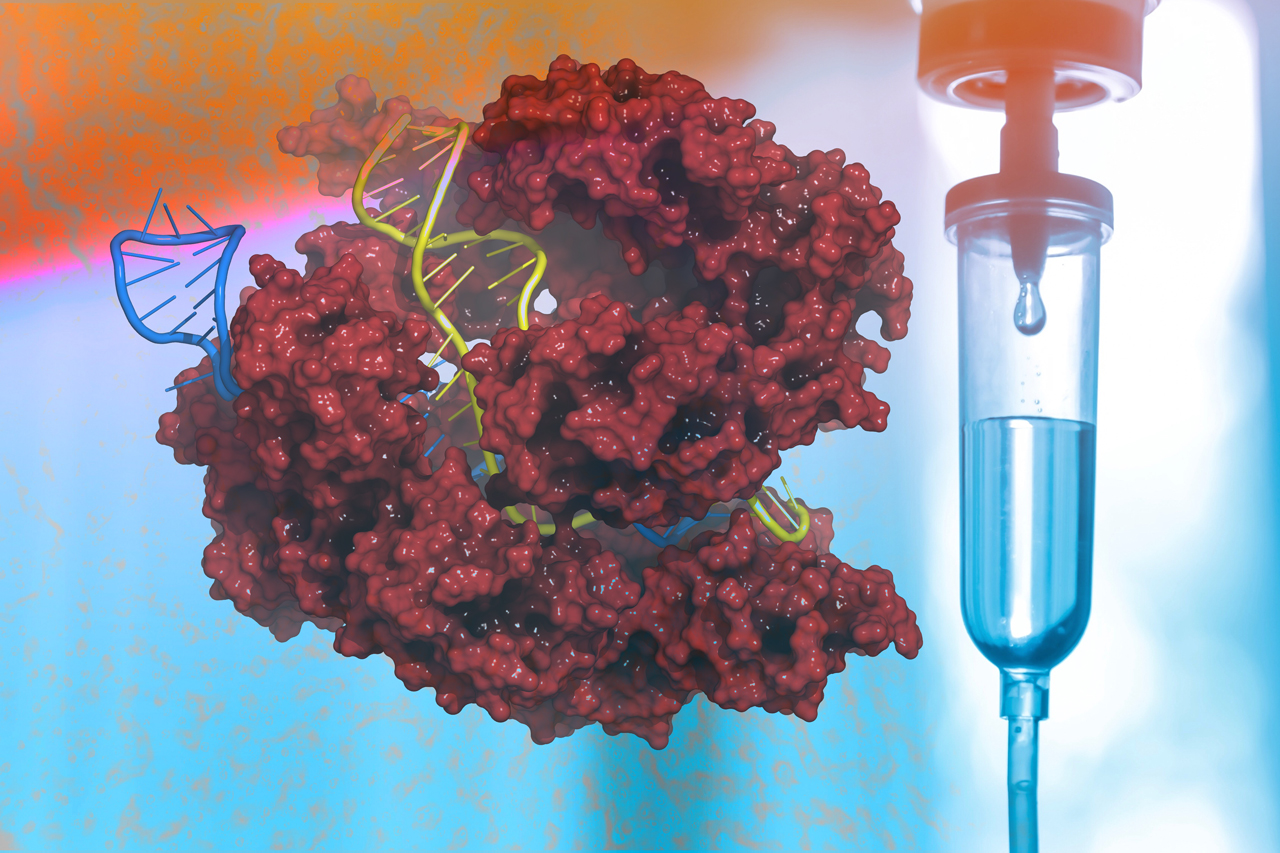Looking for something?
A Momentous CRISPR Milestone was Achieved with Remarkable Results

Intellia Therapeutics and Regeneron Pharmaceuticals’ recent announcement is a major milestone worth celebrating. They shared interim data from the first ever human study using systemically administered CRISPR as a gene editing therapy. Early results that surpassed expectations show that not only is the CRISPR-based therapy to treat ATTR amyloidosis safe, it also precisely edited the desired gene in the target cells and the larger dose produced astonishing deep reductions in serum TTR levels after a single dose.
ATTR amyloidosis: a devastating disease
Transthyretin amyloidosis (ATTR amyloidosis) is a rare, fatal disease that is an excellent target for new medical technologies that disable disease-causing genes. It is an optimal target because it is a disease in which halting production of a specific protein (TTR) clearly causes disease symptoms to stop progressing. The first siRNA therapeutic to be approved by the FDA treats ATTR amyloidosis, and now a CRISPR-based therapy developed to treat this disease may lead the way into a new era of in vivo gene-editing technologies.
There are two main forms of ATTR amyloidosis, wild-type and hereditary. Wild-type is acquired and develops with age. Hereditary (hATTR) may be caused by more than 100 different pathogenic mutations in the transthyretin gene (1).
Transthyretin (TTR) is a protein made in the liver that is coded by the transthyretin (TTR) gene. The protein’s main purpose is to carry vitamin A and the thyroid hormone thyroxine in the blood. When a person has hATTR amyloidosis, abnormal TTR proteins are created which misfold, bind together forming amyloid fibrils, and are deposited into other organs, interfering with organ function. This leads to many disease manifestations in a range of tissues, including the peripheral nervous system, heart, kidneys, eyes, and digestive tract. It predominantly impacts the nerves, resulting in peripheral neuropathy, and the heart, resulting in cardiomyopathy.
In wild-type ATTR, the normal TTR protein becomes unstable, causing it to misfold. The amyloid fibrils deposit mainly in the heart, causing cardiomyopathy.
ATTR amyloidosis is progressive, irreversible, and fatal. When manifesting as cardiomyopathy, patients usually experience congestive heart failure and atrial fibrillation and may have additional symptoms of dizziness, nausea, chest pain, shortness of breath, fatigue, and swelling in the legs (2, 3). Life expectancy after diagnosis is usually only 2 to 6 years (1).
Neuropathy will often initially appear through tingling, numbness, and burning pain in the feet, lower legs, and hands. Carpal tunnel syndrome, difficulty walking, sexual impotence, gastrointestinal disturbances, urinary problems, glaucoma, and dry eye are also common symptoms as the disease progresses (2, 4, 5). Although those who are diagnosed with neuropathy with an absence of cardiomyopathy can expect to live longer, they will still generally only live 4-17 years after they are diagnosed (1).
Until recently, liver transplantation has been the gold standard of care, as the liver is the main source of amyloid. Thus, a liver transplant will slow or halt progression of peripheral neuropathy.
Recent groundbreaking treatment strategies have provided four medications that are currently approved to treat ATTR amyloidosis. Tafamidis and diflunisal stabilize the TTR protein, so it does not form amyloid fibrils. Patisiran (the first RNAi therapeutic approved by the FDA that was developed by Alnylam Pharmaceuticals) and inotersen (an ASO from Ionis Pharmaceuticals) degrade TTR mRNA, which inhibits TTR protein synthesis. Patisiran and inotersen reduce TTR by approximately 80% (6, 7). These drugs provide much needed symptom relief and functional improvement, prolong survival, and may halt disease progression. However, they are not a cure and do require ongoing administration (1). We will discuss these two advancements in oligonucleotide therapeutics for ATTR in greater depth in the near future.
A New Approach
Intellia has worked on a different approach to solving the challenge of finding a treatment for this devastating disease. They used CRISPR-Cas9 to edit the TTR gene in patients and recently shared astounding results. Six people were dosed with Intellia’s investigational genome editing treatment (NTLA-2001) for ATTR amyloidosis. 28 days after receiving a single infusion of NTLA-2001, serum TTR was greatly reduced, and no serious adverse events were observed. TTR reduction was dose dependent, and the three patients who received the lower dose of .1mg/kg of body weight had a 47 to 56% reduction after 28 days. However, the three patients who received the larger dose of .3mg/kg of body weight had 80%, 84%, and 96% reductions in TTR concentration after 28 days. This is incredible, as current therapies reduce TTR concentrations by approximately 80% (1).
John Leonard, president of Intellia explained that “When you get to numbers like 96%, that’s where you start to give the body a chance to clean up what has been deposited.” This means that not only will symptoms stop worsening, but they could also potentially improve. In the best-case scenario, the disease could even be cured.
That would be tremendous news for those suffering from pain, decreased mobility, heart disease, or any of the other myriad symptoms associated with ATTR amyloidosis. Although these early results did not determine clinical effects, it has been shown that reduced TTR serum levels result in benefit to the patient. So, it is highly probable that patients treated with NTLA-2001 will also display positive clinical effects.
Another exciting milestone was achieved in this trial
NTLA-2001 was infused into the bloodstream, which shows that CRISPR-Cas9 components can safely be delivered in this way and will precisely edit target cells. This is immensely promising for additional uses of CRISPR to treat diseases.
How the treatment works
NTLA-2001 is based on the Nobel Prize-winning CRISPR-Cas9 technology. (Read more about CRISPR-Cas9 history and uses here.) It is an in vivo gene editing therapy, intended to edit TTR in hepatocytes (liver cells), resulting in lower production of both wild-type and mutant TTR (1).
NTLA-2001 consists of a lipid nanoparticle (LPN) delivery system, which carries a single guide RNA (sgRNA) and a human-codon-optimized mRNA sequence of Streptococcus pyogenes Cas9 protein (1).
After intravenous administration, the proprietary LPN delivery system targets hepatocytes, since almost all circulating TTR is produced in the liver. Once in the cell, the LPN breaks down, releasing Cas9 mRNA and the sgRNA that targets human TTR. The Cas9 mRNA molecule is translated, producing a Cas9 endonuclease enzyme, which then interacts with the TTR-specific sgRNA. Together, they form the CRISPR-Cas9 ribonucleoprotein complex. The CRISPR-Cas9 complex enters the nucleus where it accesses and cleaves the target DNA sequence, then DNA repair mechanisms join the ends of the cut. This introduces indels (indels is the abbreviation for insertions or deletion of bases) into the TTR gene, which causes frameshift mutations. The resulting knockout mutation prevents production of the misfolded TTR protein (1). (A lovely illustration of the process can be viewed in Figure 1 of this article by Gillmore, et al. (1).)
As seen in the early results, the process worked even better than anticipated with durable, deep reductions in serum TTR concentration for patients who received a single dose of .3mg/kg of body weight. It was well tolerated, with only mild adverse events (1).
In pre-clinical trials, TTR levels were still maximally suppressed in transgenic mice 12 months after receiving a dose. Cynomolgus monkeys sustained a 94% reduction in serum TTR protein over 12 months. Between preclinical results and the recently announced interim results in the human trials, there is a high probability that humans can also achieve these phenomenal results (1).
As Julian Gillmore, M.D., Ph.D., and the Phase 1 study’s national coordinating investigator stated, “This approach could deliver life-changing, lifelong benefits to patients with all forms of ATTR amyloidosis, who continue to experience debilitating symptoms and complications of disease while on the standard of care. While further investigation is needed, these results are highly encouraging.”
Patients will be monitored to ascertain the long-term safety of the drug, and how long the effects last. This trial only included patients with polyneuropathy that did not yet display motor symptoms and a New York Heart Association heart failure class of 1 (which means there was no limitation of physical activity and ordinary physical activity does not cause undue fatigue, palpitation, or shortness of breath).
Intellia will refine the dose, then determine whether NTLA-2001 can be used to treat a broader patient population. Their goal is to address all forms of ATTR, regardless of disease type.
Further trials will evaluate whether higher doses will consistently produce greater reductions in serum TTR concentration, which would potentially provide greater clinical benefit. If so, NTLA-2001 could be the first curative treatment for ATTR amyloidosis – with only one dose required!
Impacting the Future
As seen in the development of other novel products, when one company successfully develops an innovative technology, it opens the door for similar technologies to be tested. Many other gene-editing technologies are in development and this success may help pave the way.
Gene editing platforms are also easily adapted to other gene targets, allowing rapid development of treatments for genetic diseases. The approach used by Intellia is a perfect example of this, as it is modular and may be adapted to treat other diseases simply by changing the sgRNA. In addition to knocking out expression of harmful proteins, the proprietary non-viral lipid nanoparticle platform could potentially also be used to insert genes to produce functional proteins (1). It is currently being investigated to treat other diseases utilizing both these methods. Intellia plans to move quickly to advance and expand its pipeline using the proprietary platform.
Currently, Intellia has a development candidate, NTLA-2002, intended for the treatment of hereditary angioedema (HAE). HAE is caused by increased levels of bradykinin, a protein that causes unpredictable, recurring, severe swelling attacks in various parts of the body. The swelling usually occurs in the limbs, face, intestinal tract, and airway, and is significantly debilitating and disabling. Knocking out the prekallikrein B1 (KLKB1) gene may prevent unregulated production of bradykinin, reducing the frequency and severity of the swelling attacks.
Intellia and Regeneron are co-developing a potential hemophilia A and B CRISPR-Cas9-based treatment. Rather than gene knockout, this approach uses targeted insertion of a functional gene. To treat hemophilia B, the gene inserted is Factor 9 (F9), a gene that encodes FIX, a blood-clotting protein that is missing or defective in hemophilia B patients.
Another recent presentation of preclinical data by Intellia displayed that they could expand their in vivo capabilities originally designed for liver applications to enable editing of bone marrow and hematopoietic stem cells (HSCs) in mice. This could transform the treatment of sickle cell disease and other inherited blood disorders, avoiding bone marrow transplantation.
Safe, effective in vivo gene editing using CRISPR-Cas9 that provides long-lasting results after a single systemic infusion is a monumental breakthrough. We may be witnessing the dawning of a new era of medicine in which editing genes to cure previously uncurable, devastating diseases is a reality.








